
Bandelier National Monument is a 33,677-acre (13,629 ha) United States National Monument near Los Alamos in Sandoval and Los Alamos counties, New Mexico. The monument preserves the homes and territory of the Ancestral Puebloans of a later era in the Southwest. Most of the pueblo structures date to two eras, dating between 1150 and 1600 AD.

Pecos National Historical Park is a United States National Historical Park in San Miguel and Santa Fe Counties, New Mexico. The park, operated by the National Park Service, encompasses thousands of acres of landscape infused with historical elements from prehistoric archaeological ruins to 19th-century ranches, to a battlefield of the American Civil War. Its largest single feature is Pecos Pueblo also known as Cicuye Pueblo, a Native American community abandoned in historic times. First a state monument in 1935, it was made Pecos National Monument in 1965, and greatly enlarged and renamed in 1990. Two sites within the park, the pueblo and the Glorieta Pass Battlefield, are National Historic Landmarks.
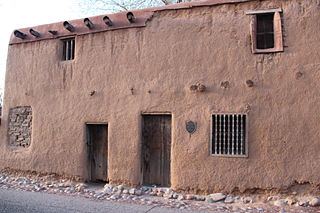
The De Vargas Street House, often referred to as the Oldest House, is a historic building in Santa Fe, New Mexico, which is often said to be one of the oldest buildings in United States. The original date of construction is unknown but the majority of the building is believed to date to the Spanish colonial period (post-1610). One archaeological study also concluded that some sections of the walls are characteristic of Pueblo architecture and may be pre-Spanish in origin. The building was listed on the National Register of Historic Places and New Mexico State Register of Cultural Properties in 1968 as a contributing property in the Barrio De Analco Historic District.

This is a list of properties and districts in New Mexico that are on the National Register of Historic Places. There are more than 1,100 listings. Of these, 46 are National Historic Landmarks. There are listings in each of the state's 33 counties.

Las Trampas or just Trampas, is a small unincorporated town in Taos County, New Mexico. Founded in 1751, its center retains the original early Spanish colonial defensive layout from that time, as well as the 18th-century San José de Gracia Church, one of the finest surviving examples of Spanish Colonial church architecture in the United States. The village center was designated a National Historic Landmark District in 1967.

The Palace of the Governors (1610) is an adobe structure located on Palace Avenue on the Plaza of Santa Fe, New Mexico, between Lincoln Avenue and Washington Avenue. It is within the Santa Fe Historic District and it served as the seat of government for the state of New Mexico for centuries. The Palace of the Governors is the oldest continuously occupied public building in the United States.

San Miguel Mission, also known as San Miguel Chapel, is a Spanish colonial mission church in Santa Fe, New Mexico. Originally built around 1610, it is often referred to as the oldest church in the United States, though it is likely that little of the original structure is still present. The church was rebuilt twice, once in the mid to late 17th century, and again in 1710 following the Pueblo Revolt. In both cases earlier pieces of the building may have been reused, though it is unclear to what extent. The wooden reredos, which includes a wooden statue of Saint Michael dating back to at least 1709, was added in 1798.

St. Michael's High School is a private Catholic junior/senior high school located in Santa Fe, New Mexico. It is privately run under the auspices of the international Institute of the Brothers of the Christian Schools, better known as the De La Salle Christian Brothers.
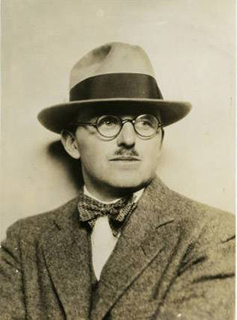
John Gaw Meem IV was an American architect based in Santa Fe, New Mexico. He is best known for his instrumental role in the development and popularization of the Pueblo Revival Style and as a proponent of architectural Regionalism in the face of international modernism. Meem is regarded as one of the most important and influential architects to have worked in New Mexico.

The Pueblo Revival style or Santa Fe style is a regional architectural style of the Southwestern United States, which draws its inspiration from traditional Pueblo architecture and the Spanish missions in New Mexico. The style developed at the beginning of the 20th century and reached its greatest popularity in the 1920s and 1930s, though it is still commonly used for new buildings. Pueblo style architecture is most prevalent in the state of New Mexico.

The Santa Fe Plaza is a National Historic Landmark in downtown Santa Fe, New Mexico in the style of traditional Spanish-American colonial cities. The plaza, or city square, was originally, and is still to this day, the center gathering place in town. Many know it as "the heart of Santa Fe". The landmark has since grown into a playground for many tourists interested in Spanish, Native American, and Mexican cultures, and includes music, design, jewelry, art and dance. It is home to annual events including Fiestas de Santa Fe, the Spanish Market, the Santa Fe Bandstand, and the Santa Fe Indian Market.

The following is an alphabetical list of articles related to the U.S. state of New Mexico.

San Estévan del Rey Mission Church is a Spanish mission church on the Acoma Pueblo Reservation in western New Mexico. Built between 1629 and 1641, it is one of the finest extant examples of hybrid Spanish Colonial and Puebloan architectural styles. It was named for Saint Stephen I of Hungary. The church was declared a National Historic Landmark in 1970, and is listed on the National Register of Historic Places.
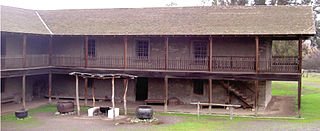
Monterey Colonial is an architectural style developed in Alta California. Although usually categorized as a sub-style of Spanish Colonial style, the Monterey style is native to the post-colonial Mexican era of Alta California. Creators of the Monterey style were mostly recent immigrants from New England states of the US, who brought familiar vernacular building styles and methods with them to California.
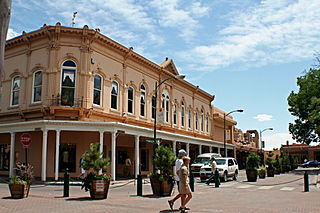
Santa Fe is the capital of the U.S. state of New Mexico. It is the fourth-largest city in New Mexico with a population of 84,683 in 2019, the county seat of Santa Fe County, and its metropolitan area is part of the larger Albuquerque–Santa Fe–Las Vegas combined statistical area, with a population of 1,178,664 in 2018. The city was founded in 1610 as the capital of Nuevo México, after it replaced the capital San Juan de los Caballeros at San Gabriel de Yungue-Ouinge, which makes it the oldest state capital in the United States. With an elevation of 7,199 feet, it is also the state capital with the highest elevation.

The following outline is provided as an overview of and topical guide to the U.S. state of New Mexico:

Northern Rio Grande National Heritage Area is a federally designated National Heritage Area in the U.S. state of New Mexico. The national heritage area includes a section of the upper Rio Grande Valley that has been inhabited by the Puebloan peoples since the early Pre-Columbian era.

Taos Downtown Historic District is a historic district in Taos, New Mexico. Taos "played a major role in the development of New Mexico, under Spanish, Mexican, and American governments." It a key historical feature of the Enchanted Circle Scenic Byway of northern New Mexico.
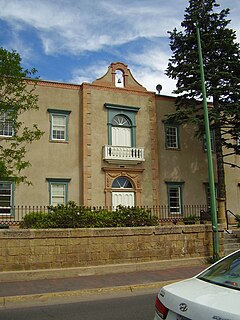
The Lamy Building, also known as St. Michael's Dormitory, is a historic building in Santa Fe, New Mexico. It was built in 1878 as the main building of St. Michael's College, the predecessor of St. Michael's High School and the College of Santa Fe. The building is a contributing property in the Barrio De Analco Historic District and currently serves as the headquarters of the New Mexico Tourism Department.

The Gregorio Crespin House, at 132 E. De Vargas St. in Santa Fe, New Mexico, was listed on the National Register of Historic Places in 1975. The listing included two contributing buildings. It has also been known as the Van Stone House.






















